
Dance at MIT!!! [Collab with Ben O. ’19] by Ankita D. '23
hip-hop? contemp? bhangra? lion dance? MIT's got it all
Ben O. ’19 and I decided to team up to talk about all the dance teams here at MIT. We’re both active members of the dance community; we joined Mocha Moves in Fall ‘19 and are members of Dance Troupe, but I’ve done it only one semester and Ben’s done it for years. He obviously has been dancing at MIT a lot longer than I have, but since we’re both pretty involved in dance, we thought we’d talk about all the opportunities to explore here, as well as our own dance journeys. I know that as a prefrosh, I didn’t know anything about these groups, so I hope this helps! :)
Overview
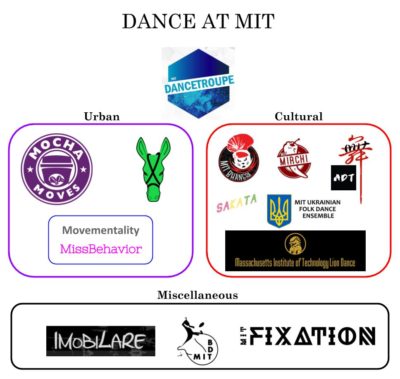
All Styles/Levels:
Dance Troupe — biggest dance organization, has styles like contemporary, urban, African/Caribbean, fusion, jazz, Latin, tap, step, and more!
Urban:
Mocha Moves — advanced urban dance team, hosts two shows each year: Ring the Alarm and Mocha Show
Ridonkulous — advanced urban dance team, hosts annual showcase called Footwork
Movementality — an all-male hip hop dance team that’s memey and lots of fun
MissBehavior — an all-female urban dance team; has dancers from a diverse range of teams that represent styles like hip-hop, contemporary, African, Bollywood, etc
Cultural:
MIT Bhangra — Bhangra is a super high-energy folk dance that originates from the Indian state Punjab; it’s lit and so is this team!
MIT Mirchi — a Bollywood fusion dance team that incorporates styles from Indian classical dance, Bollywood, Bhangra, contemporary, and hip-hop
Asian Dance Team — focuses on East Asian dance, from traditional Asian dance to K-Pop; members perform at a biannual showcase and also can participate in ADT dance cover videos
Sakata Afrique — African-Caribbean dance group that aims to introduce Afro-Carribean dance to the MIT community; members dance to afrobeats, dancehall, soca, reggaeton, and more!
MIT Lion Dance — lion dancing is a distinctive Chinese cultural art that this group aims to celebrate; the team performs at lots of events all over campus!
MIT Ukrainian Folk Dance — Ukrainian folk dance is a form of dance that features squats, jumps, and lively music. The team performs at MIT events and at venues for the Boston Ukrainian community and also teaches workshops.
Miscellaneous:
Imobilare — a Bboy crew that teaches breakdance workshops and performs at various campus events
Ballroom Dance Team — a no-experience-required, competitive ballroom dance team with MIT/Wellesley affiliates
MIT Fixation — a competitive contemporary dance team; they’re SO GRACEFUL AND AMAZING AHHH
Our Dance Journeys
(Color-coded orange for Ankita and purple for Ben)
How did you start dancing?
I honestly can’t remember a time in my life when I wasn’t dancing—I remember learning the dances in the movie Another Cinderella Story as a seven-year-old and busting it down to All Star by Smash Mouth when I was even younger. Dance was the best means of channeling all my energy and excitement into a cohesive format, so I would pretty much always be moving in some shape or form.
I started learning choreographed dances when I discovered K-Pop in 4th grade (it was actually because of a Ke$ha phase…Run Devil Run really opened doors for me lmao). I realized that countless choreography videos for K-Pop songs were available on YouTube for me to learn, so I started mirroring and slowing videos so I could mimic them.
A few years later, I started learning dances from the choreography videos of legit dance studios (namely 1Million and Millennium). Learning these dances became my favorite hobby, and eventually, I started filming videos of myself for my Instagram. I would learn a few dances a week since creating my own dance videos was so fun for me. Over the years, I’ve learned over 250 dances!
As far back as I can remember I have been dancing. Family gatherings were incomplete without everyone coming to the dance floor and moving through the “electric slide” and hopping to the beats of “wobble.” I spent hours watching and re-watching Moose embody Michael Jackson in the rainy closing scene of Step Up 2. I would walk around the house trying to copy the robotic movements of the infamous Madd Chadd, and a trip to Sparkles roller-skating was incomplete unless I tried, at least once, to join in on the dance line that seemed to move effortlessly around the rink.
I have always loved to dance. Music and motion have always had a direct link to each other, and in all honestly I cannot go back to a moment in my life when that link formed, but I must have been a very different person without it. Now, let me be straight, loving to dance and being good at dancing are two very very different things. I still think of myself as very much a beginner in the world of dance, and only started training and taking dance seriously within the last couple of years, but to answer the question “how did I start dancing” the only answer I have for you guys is… the first time I heard a song I started to move to the beat and the rest is history.
What’s your prior experience?
Besides learning dances off YouTube, none. I didn’t know what a ball change or pas de bourree (literally thought it was potpourri for a while) was before starting dance at MIT.
I’d say that I had exposure to a lot of urban dance because I’d learn choreography from a wide range of dancers, but I definitely never had any legitimate training. Workshops weren’t very accessible for me either; the only ones I attended before the Mocha Moves one at CPW were two 1Million Dance Studio ones all the way in NYC.
My prior dance experience before coming to MIT include, trying to impress a girl doing a baby freeze and scratching my face my freshman year of high school. The Dougie during my eighth-grade dance was a vibe. Umm, my 5th-grade class did the dance to crank that by soulja boy. My little brother, and sister would go out in the grass with me sometimes and we would practice the worm back in like 2nd grade, that was always fun. And then of course, as mentioned before the electric slide and wobble at any family gathering.
What got you involved in dance at MIT?
I always knew I was going to be active in the dance community in college—I’d been dancing alone in my room for so long that I couldn’t imagine not joining at least one dance group at MIT. I was pretty sure that I wanted to join Mocha Moves since they seemed badass and I really liked the set they performed at CPW, but I was also interested in Ridonkulous, the other main urban group.
When I got to MIT, I was really excited to discover that the dance community extends far beyond just Mocha and Donk. I heard about Dance Troupe from its president, who lives on my floor, and decided to join since it seemed like a low commitment yet fun way to meet lots of dancers. I also was interested in Mirchi since I’d never really done Bollywood fusion before, but eventually decided that I wanted to focus on urban dance for my first year in college. I ended up getting into both Mocha and Donk, but chose to just do Mocha since I didn’t think I’d have the time for both. I’m really happy that I decided to do Mocha and one DT dance my first semester since it was just enough to introduce me to dancing/performing with a team without being too intense.
Like a lot of students when I first got MIT I was kind of overwhelmed by just the sheer amount of stuff that I could do when I got on campus. I knew I wanted to do something outside of academics, just so I had a hobby of some sort, but in all honesty I was very unsure of what exactly I wanted to get involved with.
Thankfully, I had a few friends that were pretty set on what they wanted to. My boys David Onyemelukwe and Bryan Chen got to campus and were determined to hop right into the dance scene so I more or less just followed them. Through their influence and the guidance of an MIT junior Tim Nguyen who was already pretty involved in the dance community here, we found ourselves at Dance Troupe auditions, MIT Mocha Moves auditions, and MIT Ridonkulous auditions.
I, of course, made neither Mocha Moves nor Ridonkulous my first go around, because I had never actually done choreographed dancing before, but I did manage to get a spot on an intermediate dance in Dance Troupe and thus started my journey as a dancer at MIT!
What groups are you a part of?
I’m a part of Mocha Moves and Dance Troupe.
I am currently a member of MIT Mocha Moves and MIT Movementality, and I have choreographed and danced for MIT Dance Troupe.
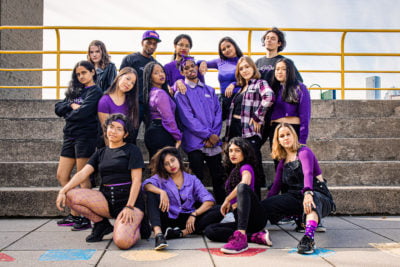
mocha! <3
What was getting into Mocha Moves like for you?
I got into Mocha in my freshman fall. It was my second dance audition ever, the first being the Donk audition that was right before it, so it was out of my comfort zone since I was so used to dancing for fun. Honestly, though, the freestyle section of the audition was the only part that could’ve been considered stressful. Looking back, I came into MIT pretty confident that I’d get onto any hip hop/urban team I auditioned for, which is hilarious to me now that I’ve been on the other side of the audition process. Being a member of a team has taught me how little I know about all the facets of dance, from choreo retention and musicality to technique and body control. Dancing alongside people who have trained and grown so much in their time at MIT has completely expanded my view of dance, and now I’m only excited for how much I’ll improve in the next three years.
Getting into Mocha was a very long process for me. I tried out the first time my freshman fall when I first got to MIT. However, I had never really tried choreographed dancing before and I just ended remembering almost none of the choreo by the end of the audition.
Needless to say, I didn’t make the team my freshman fall but it did give me… perspective, for lack of a better word. I had always enjoyed dancing in very casual settings but it became very clear to me very quickly that freestyling with my friends and being able to perform choreography were two completely different skills. So from there, I joined Dance Troupe.
I joined an intermediate dance and started to learn the basics of choreographed dancing. I learned words like textures, choreo retention, speed change, hitting pictures, and so much more. I was able to perform in two sets at the end of that semester, but after all of that dancing, I slowly began to learn how much there was that I didn’t know. So rather than auditioning again the next semester, I decided to continue to learn more about dance, and this is when I made a very crucial discovery to my dance career…. dance exists outside of MIT!
Over the next year I started spending time going to workshops around Boston and asking the more experienced dancers at MIT where I could go to improve my dancing ability. Moving my dancing to outside of MIT gave me even more perspective about how much growing I had to do as a dancers. Outside of MIT there are people who really focus on dance as their entire life. Watching these individuals dance really put a passion in me to improve and hopefully become half as good as they are.
At the end of my sophomore year I had an opportunity to move to shanghai and there my dancing kind of slowed down a bit. I did join two amazing dance teams in Shanghai where I learned about how different dance was in different parts of the world; however, I did not focus as much on the individual training and getting better. Because of that, when I did come back and auditioned for Mocha my second time I did not make the team yet again, but I was not discouraged. My focus had moved from getting onto Mocha, to trying to become a better dancer, and with getting better would become more opportunities to join teams.
I spent the next year on personal growth, and really improving through more workshops and really watching those that I admired to see what it was that made them different. After that year of training I tried out for Mocha one more time my senior fall, and I MADE IT. I say all of that to say, if you start dancing in college don’t give up if you don’t start off on a competition team right out the gate. Getting better takes time and dedication, but if you do put in that time and are very critical about your improvement, you can do anything you put your mind to.
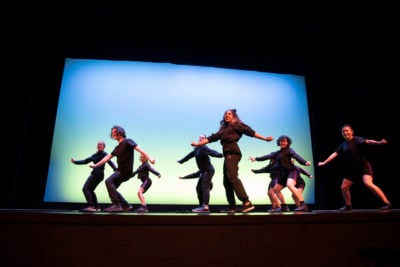
us performing at Funktion
How are Mocha Moves and Dance Troupe?
I LOVE Mocha. Initially, I thought the six hours of practice a week of practice were kind of tedious; after we learned all the sections of our first set and moved onto cleaning and drilling the choreography, I felt as if dancing on the team wasn’t exciting anymore. Those feelings only lasted a week or two, though; once we performed at World of Dance and Funktion, I realized how gratifying being a member of a team is. Also, spending long days at performances only brought me closer to my team, and I’m really close to everyone on it now.
Mocha has different commitments throughout the year. In Fall, we focus on World of Dance, a competition where teams and individuals from all over the Boston area perform, as well as Ring the Alarm (RTA), our own intercollegiate dance competition that we host on campus. I really enjoy the 4-5 minute sets we learn for each event—especially RTA (Gas Pedal cameoooo)—and love how every section is so different because it has different pairs of choreographers.
In December, we perform at DT shows, which is a blast (looking at you, Friday 10pm). After that, we don’t really have any commitments until after the holiday break, but we do have Mocha Formal, an event where we all dress fancy, eat a ton of food, and discuss our choreography ideas for the upcoming Mocha Show. Mocha Show is an event in February that’s entirely choreographed and performed by us. It has 10-13 dances and is around 2 hours long, so it’s like a mini DT show. (People can choose as many or few dances as they want. If you’re gone for IAP, you can still participate, but you’ll be in fewer dances/sections.)
…And if you consider how we had six hours of practice a week for two sets in Fall, then the amount of time we spend preparing for Mocha Show seems pretty daunting.
Well, yeah, it definitely is. We all dance up to 5 hours a day, sometimes more on weekends (yes, we have practice every single day). I usually have 2-4 hours a day, for an average of about 20 hours a week. And to think I thought six hours a week was too much…
Honestly, Mocha Show seems like a lot, but I’m so grateful for the opportunity to participate in it. I’ve choreographed before, but it’s been more of a “string moves together and hope for the best” situation since it was mostly for myself. For Mocha Show, though, I choreographed two pieces, staging and all, for the first time. Choreographing and teaching is new to me, and I struggle a lot, but seeing the team perform my pieces is really gratifying.
Mocha Show is in a few weeks (2/14 and 2/15), so we haven’t gotten over that particular hurdle yet, but when Spring comes around, we’re back on the performance grind. We create a new set that’s comprised of Mocha Show pieces and perform it at various shows, including CPW!
As for DT, I love it and I’m so glad I decided to join! I did only the advanced urban dance last aka my first semester, but it was super fun and rewarding. Next semester, I’m planning on choreographing, and I literally can’t wait
Dance Troupe is where dancing started for me. Dance troupe spans from absolute beginner to advanced dancers and really has room for you to learn and experiment with any kind of dance you would like.
Dance Troupe is less of a single team and more like a group of teams. Every semester people who would like to choreograph and make a set (4-5 one-ish minute songs normally makes up one set). These individuals or groups of people then get to audition their set and have it be selected for a spot in the DT show at the end of the semester. In the past, there has been urban, contemporary, step, breaking, tap, ballroom, etc. all of which have been featured at the end of the semester.
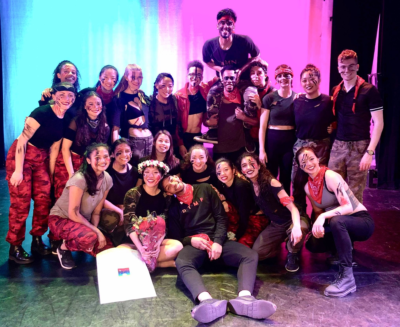
the junior spring advanced dance section, Ben’s last time dancing with the class of 2019
After the sets have been chosen, the choreographers who are in charge of each set have a day of giving a sneak peek to their piece and anyone who is hoping to be in the show at the end of the semester comes to watch and decide which sets they would like to be in. The next day there is an audition in which the choreographers choose which dancers they would like to have in their set. As said before the potential pieces span all genres and all skill levels, so there is honestly a place for anyone.
Practices are held once a week per set you have chosen to be in, and throughout the semester there are showings in which each set performs in front of everyone else in DT to show how the pieces are coming together.
At the end of the semester there is a weekend of shows in which all of the sets perform. There are lights, costumes, and a ton of dancing, making it one of my favorite times of the year.
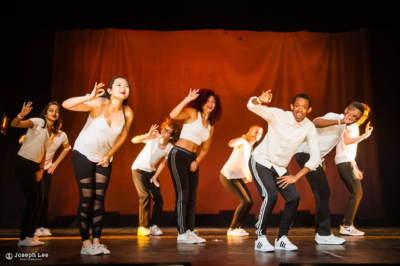
DT means family
For me DT is where I started dancing at MIT and will always have a special place in my heart. I have been in DT every semester of MIT, and choreographed a set this last semester. If you are ever trying to find a place to start dancing at MIT, to grow as a dancer, or to show off your growth and choreography there is no better place than DT.
How do you practice dancing?
I’d like to say that I attend workshops frequently, but I really don’t…when I’m not dancing for Mocha or DT, I’m learning dances off YouTube like how I did in the past. I don’t keep up with new choreography videos as much as I used to, but when I come across really good ones, I’m sure to save them for a time when I’m not too hosed with my other dance commitments.
I try to set dancing challenges and goals for myself. I have standard training practice, these include things like going to some number of workshops a month, or making some number of pieces. My other practice normally includes working on a piece of my dancing I want to improve on. I may be working on my bounce and spend some amount of time a day working on bouncing drills, or wave drills, or chest drills, and trying to incorporate these different parts of dance into my normal freestyling and choreo making. Lastly, I have my standard practice and this includes going to Mocha, MMT, and DT practices during the week.
Other Dance Teams
We asked representatives from other teams to answer the following questions:
- What kind of dance does this team primarily pursue?
- What kinds of events do you participate in throughout the year?
- What does this team mean to you?
Here are their responses!
What kind of dance does this team primarily pursue?
(Nathan Liang, Lion Dance Team)
The MIT Lion Dance team primarily practices hok san lion dancing, which is a more relaxed, less traditional style of lion dancing. Though more recently we have been trying to learn more fut san style, which has a stronger focus on kung fu style, choreographed movements.
2. We do a lot of lunar new year performances for corporate events or other festive college events. We also usually guest perform at ADT’s showcase every semester, Nightmarket in the fall, CSC’s banquet, and any other on-campus events that we’re invited to perform at.
(Claudia Chen, Fixation)
Fixation is MIT’s contemporary dance team. Contemporary dance is defined as a fusion of “classical, modern, and jazz styles,” but members of Fixation come from all different types of dance backgrounds. We like to experiment with a wide range of sets, from stronger and powerful pieces to softer, more lyrical dances. The coolest part about the team is how much we all learn from each other; because we all have different strengths and weaknesses in our dancing, we all have room to grow here.
(Orisa Zari Coombs, Sakata Afrique)
Sakata is MIT’s premier Afro-Carribean dance team created to increase the presence of Afro-Carribean art on campus and create a space for students to learn and partake in its culture. We dance to afrobeats, dancehall, soca, reggaeton, and anything else that falls into the African Diaspora. We incorporate traditional as well as contemporary and trendy dance moves from the cultures we represent.
(Yun Gu, Ridonkulous)
Donk primarily does urban dance, which means we make choreography that is influenced by many different dance styles, the most prominent being hip hop. Everyone on our team comes from varied backgrounds in dance as well, so we try to play to people’s strengths while encouraging each person to grow in styles they are less familiar with.
(Kristy Chang, Asian Dance Team)
MIT Asian Dance Team primarily performs traditional Chinese dances and modern Asian pop dances, mostly K-pop dances. ADT also films and dances in K-pop covers that are released on our YouTube channel.
(Avital Weinberg, MissBehavior)
MissBehavior, founded in Spring 2019, is MIT’s first all-female urban dance team. We created the team to support female dancers at MIT and provide a space for us to grow and learn from each other through urban dance. Our specific urban style varies each semester based on the diverse group of dancers and choreographers on our team. This semester we have members that dance with almost every other dance group on campus spanning all different genres from hip-hop to contemporary, and even African and Bollywood! Overall, we aim to explore beyond our comfort zones and create entertaining urban pieces for MIT and the broader Boston dance community.
(Brent Samuels, Movementality)
MoveMentality primarily does urban dance. Within the urban dance style we predominantly pursue commercial hip-hop and street jazz.
(Lauren Cooper, Imobilare)
Breaking is a highly athletic and acrobatic form of dance commonly known as breakdancing. MIT Imobilare is a breaking group that consists of undergrads, grad students, and/or post docs who share a love of freestyle and movement.
(Pranav Murugan and Anisha Agarwal, Mirchi)
As a fusion team, we pursue tons of different styles, including hip hop, Bollywood, contemporary, Indian classical, bhangra and more.
(Joanna Lin, MIT Ballroom)
Our team pursues competitive ballroom dance, also known as DanceSport. It comprises of 19 dances, divided into four styles: International Standard, American Smooth, American Rhythm, and International Latin. At competitions, the Syllabus levels cover Newcomer, Bronze, Silver, and Gold, and the Open levels are Novice, Pre-Championship, and Championship. We work with professional ballroom coaches to focus on awareness of our muscles, bones, and joints, and how we can harness them to dance safely, efficiently, and beautifully.
(Anita Dey Barsukova, MIT Ukrainian Folk Dance)
We practice and perform Ukrainian Folk Dance, which is a broad term for various Ukrainian cultural dances. One of the most recognizable dances we perform is Hopak, a traditional Ukrainian dance originally performed by Cossacks (Ukrainian warriors/fighters) that features impressive squats, jumps, and kicks as well as beautiful costumes and lively music. Think dudes in poofy pants doing pike jumps and splits in mid-air, ladies with flowing ribbon headpieces doing fancy footwork; that’s Ukrainian folk dance!!
What kinds of events do you participate in throughout the year?
(Nathan Liang, Lion Dance Team)
We do a lot of lunar new year performances for corporate events or other festive college events. We also usually guest perform at ADT’s showcase every semester, Nightmarket in the fall, CSC’s banquet, and any other on-campus events that we’re invited to perform at.
(Claudia Chen, Fixation)
Even though we’re a contemporary team, we get to perform at events that are heavily dominated by urban dance groups such as World of Dance, Mocha’s Ring The Alarm, and Donk’s Footwork. We also perform at events that are not just focused around dance; for example, we’ve opened for acapella groups on campus, performed for various student group events, and danced at Harvard and BU.
(Orisa Zari Coombs, Sakata Afrique)
We perform at many African culture events at universities across the boston area, as well as cultural events hosted on campus such as those hosted by the OME, OMP, SPXCE, and Sloan. We also host our own showcase in April called AfroShake. This year we will compete for the first time in a local afrobeats competition.
(Yun Gu, Ridonkulous)
We get to perform throughout the year at various showcases and competitions all over the Boston area, including several hosted by other colleges. Ridonkulous also hosts our own showcase in April called Footwork, and this year (2020) is actually our 15th anniversary of the show (come thru)!
(Kristy Chang, Asian Dance Team)
At the end of every semester, ADT presents a showcase of around twenty dances of various styles. We also perform at a few external performances throughout the semester for different cultural events.
(Avital Weinberg, MissBehavior)
In the past year, MissBehavior has performed in numerous on-campus performances such as Relay for Life, DanceTroupe, and CSC Nightmarket. We hope to add more MIT and Boston area performances as our team gains traction in the coming semesters. This is only our third semester after all!
(Brent Samuels, Movementality)
We participate mainly in large dance showcases on campus and at nearby colleges including Mocha Moves’ Ring the Alarm, Ridonkulous’ Footwork, and Dancetroupe Showcase on campus and WAVES at Boston College and Jam On It at Wellesley off-campus.
(Lauren Cooper, Imobilare)
Most of the time, we self-coordinate times to practice together or session. We occasionally host free workshops to the student body or participate in DT with a choreographed routine so more people can become exposed to breaking.
(Pranav Murugan and Anisha Agarwal, Mirchi)
Throughout the year, we perform for some on-campus showcases (such as DT, Ring the Alarm, Footwork, etc). However, our main performances are national competitions for the fusion dance circuit across America.
(Joanna Lin, MIT Ballroom)
We start off each school year with a Dance Camp series, where everyone is welcome to learn some basic steps in both Standard and Latin dances. Team members attend collegiate competitions around the New England area such as Brown, Columbia, and Harvard, culminating in our own MIT Open, which we host at the end of April each year. We also hold monthly socials that are open to the general public and perform for various events.
(Anita Dey Barsukova, MIT Ukrainian Folk Dance)
We are a fairly new group, but we perform at CPW and during Parent’s weekend, and hope to perform at cultural events like OneWorld MIT, etc. Additionally, we perform at venues for the Boston Ukrainian community, such as this year’s Malanka (Ukrainian New Year) celebration. We also hold a workshop at the beginning of each semester in which we teach basic steps and showcase fun group trick formations and squats/jumps.
What does this team mean to you?
(Nathan Liang, Lion Dance Team)
The MIT Lion Dance Team is like a close-knit family to me. We dance, learn, struggle, get sore, and get swole together. Whenever someone on the team is having a bad time, other teammates will always fill in to check on that someone and make sure they’re doing okay and if they need anything to make their day better. I really appreciate that social aspect of the team. I guess this team also has a special place in my heart because Andison and I literally built it back from the ground up after the 2018 seniors graduated our freshmen year and left us as basically the only two active members left our sophomore fall. The team has been improving and thriving and growing since, and I really hope it keeps getting better and better long after I’m gone.
(Claudia Chen, Fixation)
I grew up doing ballet and I’ve always loved to dance, but I wasn’t sure how much dancing I would do when I got to MIT. I joined Fixation during my freshman fall, and it taught me a whole new style and way of moving. This team also gave me some of my closest friends who want nothing more than the best for me- both in dancing and in life. As I’m approaching my last semester at MIT, the question of how much dance I’ll have in my future arises again, but the relationships I’ve formed with my teammates are something I’ll have forever.
(Orisa Zari Coombs, Sakata Afrique)
To me, Sakata is a chance to connect to my Caribbean heritage as well as to learn about and explore African culture. As someone who is half American Black, I don’t know where my ancestors came from, and Sakata Afrique gives me a sense of belonging and peace knowing that people across the world from all kinds of cultures with many similarities and many differences can trace their roots back to Africa the motherland. I love that we can unite and celebrate the diversity through dance. I have also found community and friends in the members of my team. One of the most important things to me about Sakata is that we are open to people of all backgrounds, regardless of dance experience or ethnicity. There is a misconception that Sakata is only for people who identify as black, but what we value most is being able to share culture with whoever is interested!
(Yun Gu, Ridonkulous)
This team means the world to me. Dancing with and leading a group of peers in doing something we love to do has been one of the most rewarding endeavors I’ve taken on at MIT. It has given me a space to move, create, and explore. I spend time with people I plan on being friends with for life, and it has allowed me to continue to meet people, both at MIT and in the greater Boston dance community, who inspire me endlessly.
(Kristy Chang, Asian Dance Team)
To me, ADT was a great way to get to know many people in the dance community at MIT. I tried out many different styles of dance, and the choreographers I had were always willing to help me improve. I enjoyed participating in the covers, and directed two of my own. I had a lot of fun with helping with the production of ADT covers, which were some of the best times I’ve had in ADT.
(Avital Weinberg, MissBehavior)
MissBehavior honestly means the world to me! It has truly been the most challenging and rewarding experience for me at MIT. To me, MissBehavior is a bridge between female dancers from different backgrounds, styles, and experiences. We are a diverse group of personalities woven together by our passion for growth, female empowerment, and dance. For many team members, including myself, MissBehavior gave us our first shot at choreographing advanced pieces and training as part of a team. I am so grateful to have witnessed the determination and support of every member in their own dance journey. I love my MissBehavior fam and can’t wait to see how the team progresses in the coming years!
(Brent Samuels, Movementality)
Just like in a lot of other sports and activities, it’s possible to lose sight of fun when you train to be competitive. MMT focuses on growth in performance and helps me reconnect with my passion for dance and the fun that I see in it while sharing that with audiences with our humorous sets. Additionally, MMT gives me a sense of community and brotherhood among male dancers. I particularly value this bond with men being in the minority in the MIT dance community.
(Lauren Cooper, Imobilare)
Breaking is a fun way to get connected with the local community while learning sick moves. I’ve enjoyed my time on the team, have made friends through the process, and hope to inspire more people to join in the future.
(Pranav Murugan and Anisha Agarwal, Mirchi)
Above anything else, Mirchi is a family! We spend so much time dancing together, but we manage to spend even more hanging out. It’s a group where everyone is welcomed and loved and encouraged to grow, both as dancers and people.
(Joanna Lin, MIT Ballroom)
MITBDT has become one of the best parts of my life. All of our classes are in the evenings, but not once has a ballroom class failed to cheer me up after a long day of classes and meetings. It’s given me the opportunity to meet such a diverse group of people, as our team is a mix of Wellesley students and MIT undergraduate and graduate students. Not only that, but meeting ballroom dancers from other schools at each competition has developed into friendships I never would have encountered. After all, waking up at 4 am and dancing in heels for 12 hours would not be quite as worth it without the love and support of everyone else there.
(Anita Dey Barsukova, MIT Ukrainian Folk Dance)
I am half Ukrainian and half Indian, and growing up, I was always connected in some way to both sides of my identity. When I got to MIT, I realized that there were no existing organizations that would allow me to keep in touch with the slavic side of my heritage, so I decided to create one!! I’ve been dancing Ukrainian Folk dance since I was 6, and its pretty lit in my opinion, so I thought, why not continue it here? Our group started small, but now consists of around 15 awesomely talented and funny people. Being able to see them and work with them, and share our niche slav memes and fun steps and tricks is always the highlight of my week. I would not give it up for the world, and I hope to spread this joy to other people at MIT! We take anyone, slav or no, and new members don’t have to have any background whatsoever in dance; only a desire to have fun and willingness to learn!
We hope this blog offered some insight into what being a dancer at MIT is like! There are so many options to explore here, so you should definitely give dance a try; no prior experience is required! We both know so many individuals who came to MIT with no experience whatsoever and are now some of the most established dancers in the community. But if you already have experience, Dance Troupe is a great place to try out a variety of new styles.
Good luck with your dance journey!